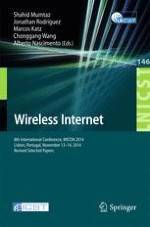2015 | Buch
Wireless Internet
8th International Conference, WICON 2014, Lisbon, Portugal, November 13-14, 2014, Revised Selected Papers
herausgegeben von: Shahid Mumtaz, Jonathan Rodriguez, Marcos Katz, Chonggang Wang, Alberto Nascimento
Verlag: Springer International Publishing
Buchreihe : Lecture Notes of the Institute for Computer Sciences, Social Informatics and Telecommunications Engineering
